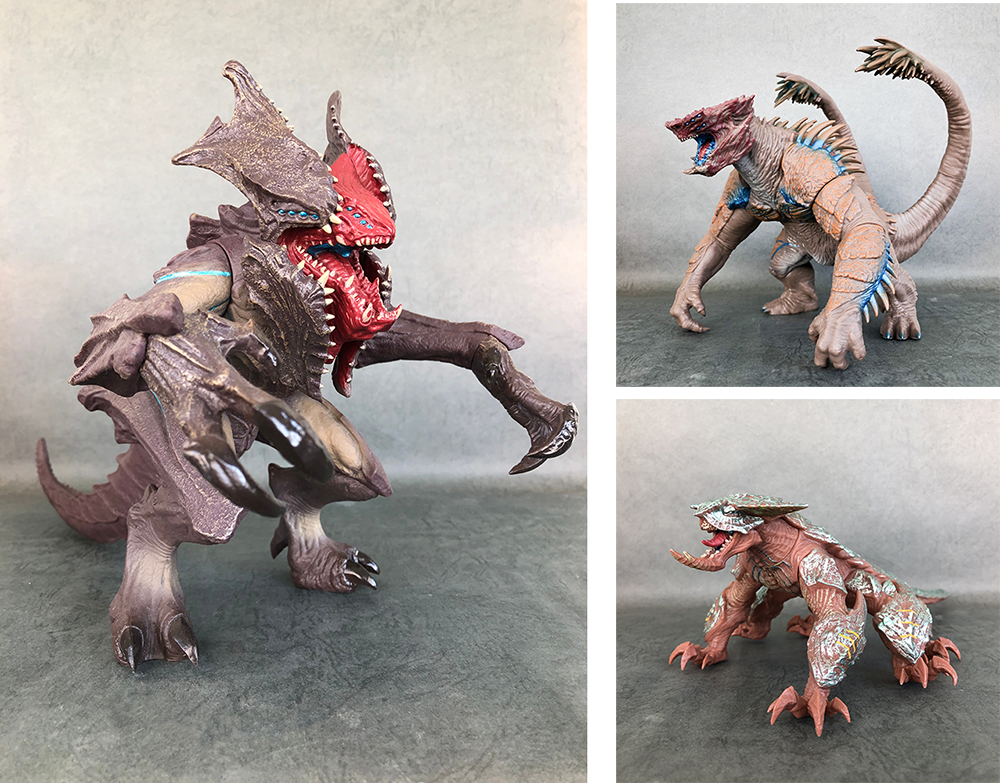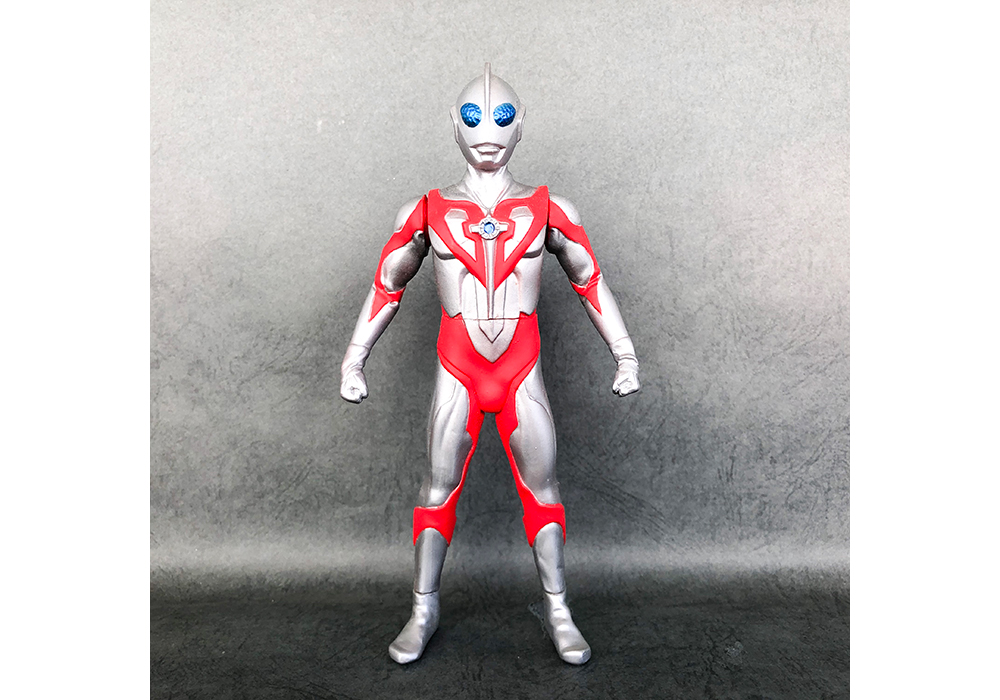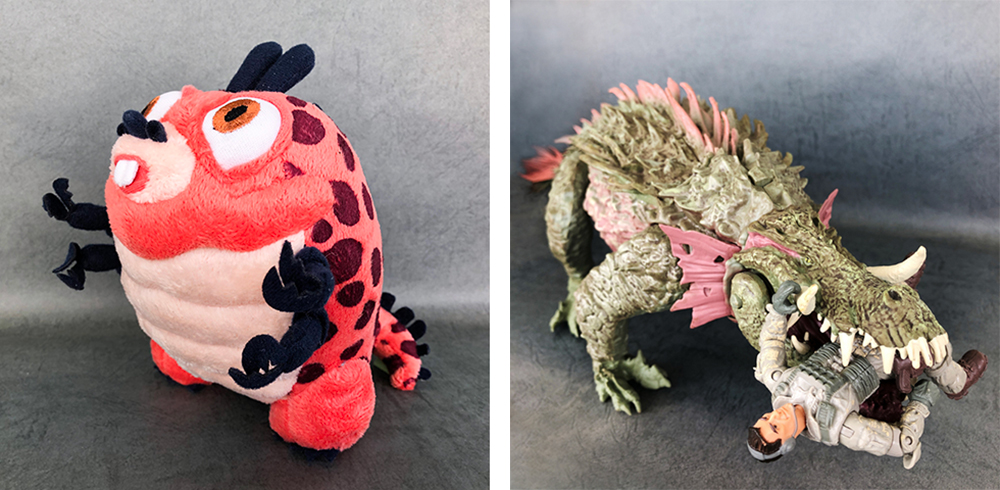The number of Hollywood-made Kaiju characters soared as the 21st century began. Today, the broadcasting period of the Ultraman series is shortened from one year to six months. New Godzilla or Gamera films haven’t been produced for long. The center of Kaiju is moving from Japan to the United States. In the final part of this article, I will look back on the last two decades of upheaval and look into the future of Kaiju.
 Left: Raijin from Pacific Rim: Uprising (2018)
Left: Raijin from Pacific Rim: Uprising (2018)
Right: Shrikethorn (top) and Hakuja (bottom) from Pacific Rim: Uprising. The previous film was set in Hong Kong. In the latest film, the three Kaiju destroy Tokyo, a mecca for Kaiju lovers.
*All the figures shown in the photographs are the author’s personal properties.
The rise of CGI Kaiju
In 1988, the Hollywood version of Godzilla directed by Roland Emmerich was released. As I briefly touched on in the last part, this film was not received very favorably. However, to cash in on its topicality, a number of similar films followed. They included Zarkorr! The Invader (1997) and Kraa! The Sea Monster (1998) that used suit actors just like Japanese special-effects films. Both the films were directed by a person by the name of Aaron Osborne. They were about fights between space Kaiju attacking big cities and humankind. There were also films featuring giant monsters in the 80s, such as Q: The Winged Serpent (1982), The Deadly Spawn (1983) and Little Shop of Horrors (1986) (*1). However, they didn’t reflect strong influence of Japanese Kaiju films. Their filmmakers might have followed the predecessors a little although that was not certain. By contrast, the teams of Zarkorr! The Invader and Kraa! The Sea Monster definitely and consciously did. The Zarkorr suit was produced by Rainbow Zokei Co., a costume and prop design company in Japan (*2). There was also a film titled Gargantua (1998). Its Japanese title Gajura sounded like Godzilla. It featured amphibians mutated with radioactivity. It was about parent-child Kaiju just like Gorgo (1961). Although produced on a very low budget, the film used a suit, a puppet and CGI. The methodology had something in common to Emmerich’s Godzilla (*3).
In the 1990s, CGI emerged as a new option to render monsters and it has become a preferred option. One of the representative examples was Octalus in Deep Rising (1998). As the name suggested, Octalus was a gigantic octopus monster. The monster stuck to the bottom of a luxury cruise liner and ate up 3,000 passengers in no time. The sheer scale of the film was very unlike Hollywood. About 10 years before the film, Leviathan (1989), Deep Star Six (1989) and other deep-sea monster films were released one after another, to capitalize on the expected success of The Abyss (1989) directed by James Cameron. In those films, such a giant monster did not appear. Octalus was worthy to be called Kaiju for its gigantic body of several tens or over 100 meters.
 Thai Ultra warrior Ultraman Millennium. It has the characteristic blue eyes. It is said that the eyes were dyed blue by the reflection of the color of the sea when it arrived on the earth. That is very romantic.
Thai Ultra warrior Ultraman Millennium. It has the characteristic blue eyes. It is said that the eyes were dyed blue by the reflection of the color of the sea when it arrived on the earth. That is very romantic.
All the films mentioned above were produced in the United States. Into the 2000s, CGI-created monsters began to increase in Asia. One good example may be Garuda (2004) produced in Thailand. The film depicted fights between Garuda, a divine bird from Hindu mythology, and god-killer special forces. The film carried the tag line “Thai Godzilla is coming” when released in Japan although Garuda was rather modest in size for Kaiju. Several scenes seemed to be taken from Japanese Kaiju films. The director must be quite a buff. As I wrote in Part 2, Japanese Kaiju characters and super heroes have been extremely popular in Thailand. In those days, Chaiyo Productions once working with Tsuburaya Productions created their own Ultra warriors such as Ultraman Millennium, Ultraman Elite and Dark Ultraman. Chaiyo planned new TV series featuring them. The plan, however, foundered because of a dispute between the two productions and the subsequent court decision. In Malaysia, its original Ultra warrior Ultraman Ribut, debuted in the 3D CG animated series Upin & Ipin in 2014, is popular. It is authorized by Tsuburaya Productions.
Kaiju loved by great filmmakers
 Left: Insectosaurus from Monsters vs. Aliens (2009)
Left: Insectosaurus from Monsters vs. Aliens (2009)
Right: Lizzie from Rampage (2018)
The two monsters are different in design concept but they are the same in that a main motif is combined with elements of a dinosaur. The former walks with two legs. The latter seems to have the fangs just to look good and they are unlikely to be of any help for predation. Those features add to their Kaiju-ness.
In Korea, monster films are released occasionally although not so often as in the U.S. or Japan. Especially, a former comedian Shim Hyung-rae is an ardent monster enthusiast directing Yanggary (2000) mentioned in Part 2 and D-War (2007) filmed on streets of Los Angeles. The storyline of the former is suggestive of Japanese Kaiju films. The climax is a face-off between the evil space Kaiju Cykor and Yanggary. Although there is a world of difference in quality, the film can be considered a forerunner of Pacific Rim (2013) as the CGI monsters are designed to look as if played by a suit actor. The latter is often criticized for the poorly constructed story but it is full of monsters from giant Korean dragons, holy Imoogi and evil Buraki, small dragons armed with heavy weapons and numerous wyverns. The high quality VFX deserves a mention. Bong Joon-Ho, a great young director known for Memories of Murder (2003), has also directed monster films, The Host (2006) and Okja (2017). He loved Godzilla series and Ultraman series in early childhood. One of the reasons for producing those films is that Korea does not have a tradition of monster films. Gwoemul in The Host and Okja, however, are not big enough to fit the definition of Kaiju proposed in this article. The same goes for monsters featured in other Korean films Chaw (2009) and Sector 7 (2011).
Now, let’s get back to the United States. In 2005, Steven Spielberg directed War of the Worlds, an adaptation of H. G. Wells’ classic sci-fi novel of the same name. The book was first published more than 100 years before. It appeared to have nothing to do with Japanese Kaiju films. However, “tripods,” the massive machines operated by aliens, were portrayed just like Kaiju. There was a line, “In Osaka, I hear people destroyed several of them.” Spielberg said that he wrote that line because Godzilla and Gomora (*4) were stricken back in Osaka. He may have said that only to be polite. Still, he was unquestionably a Kaijulover. The last scene of The Lost World: Jurassic Park (1997) was strikingly similar to the ending of Kaiju Soshingeki (Destroy All Monsters) (1968). In Ready Player One (2018), originally designed Mechagodzilla appeared as the strongest antagonist. Furthermore, DreamWorks Pictures set up by Spielberg has produced many 3D CG animated works about cult classics. Monsters vs. Aliens (2009), a homage to monster films of all ages and cultures, featured an insect mutated by exposure to radioactivity into Kaiju called Insectosaurus. Naming any creature, whether it is a lizard or an insect, something-saurus is a common thing in Kaiju films.
Tim Burton is another director famous as a Kaiju buff. One of his well-known films Mars Attacks! (1996) is said to be inspired by Kaiju Daisenso (Invasion of Astro-Monster) (1965) and Destroy All Monsters (*5). There was even a scene showing Martians watching Godzilla vs. Biollante (1989). In Frankenweenie (2012), Toshiaki’s turtle was resurrected as a giant turtle monster, which was reminiscent of Gamera. Another film you shouldn’t miss out is Cloverfield/Hakaisha (2017) produced by J. J. Abrams. He gained the inspiration for this film from Godzilla PVC figures he saw in Harajuku when he visited Japan for promoting another film of his. In this film, Kaiju of 100 meters in body length appeared. The music Roar! played while the end credits was rolling was suggestive of music by Akira Ifukube. Ifukube was one of Japan’s leading composers and he composed scores of many Kaiju films including Godzilla (1954). Looking at the works of Hollywood directors, it seems that Americans love Kaiju more than Japanese people do. There are more Hollywood films featuring monsters gigantic enough to be called Kaiju. I will just give the titles and won’t go into details as it will take forever. They include The Mist (2007), Hellboy II: The Golden Army (2008), Monsters (2011), Ghostbusters (2016), Kong: Skull Island (2017) and Rampage (2018). A little unusual monster film Colossal (2016) is a co-production between Canada and Spain. An unemployed young woman struggling with alcoholism is synchronized with Gomora-like Kaiju.
What do you think? Quite a few of you may have noticed that more and more Hollywood films have been featuring Kaiju since the 2000s. This article does not encompass all the films but it is certain that the number of such films is increasing. One of the reasons may be a rapid improvement in the specifications of personal computers. Monster suits are only suits after all. Miniature sets, however elaborately they are built, do not look real unless properly lit. Marshmallow Man in Ghostbusters (1984), although played by a suit actor and filmed with miniature sets just as in Japanese films, still holds up in the eyes of today’s audiences. However, it is a fairly rare case (*6). In other words, Kaiju characters and destruction of cities would only work in parodies that audiences knew would look cheap or in comics not subject to technical restrictions. With the help of photorealistic CGI, convincing imagery acceptable to most audiences is now made possible (*7). I said “Kaiju is a kind of disaster” in an earlier part of this article. Disaster films, which fell into decline after mass-production of poor quality works in the 1970s, have been also revitalized, thanks to progress in VFX technology. Americans love panic movies and monster films. If a film or special-effects technology is updated to fit the times, there is no way it won’t magnetize people. Besides that, Kaiju films combine those two genres. The current Kaiju craze was meant to occur. For some conservative filmmakers and long-time fans, the use of digital technology is unacceptable. However, without the technological innovation, Kaiju films could have been extinct by now. Viva CG!
In Godzilla: King of the Monsters to be released in the spring of 2019, the golden-oldie Kaiju, Mothra, Radon and King Ghidorah, will be reproduced by CG. In 2020, Godzilla vs. Kong is slated to be released. Hollywood-version Godzilla saga that failed to continue in the 1990s seems to be going well. It was announced that Starlight Runner Entertainment and The Licensing Group signed a partnership agreement with Tsuburaya Productions. The day may be near when American-made Ultraman, following Godzilla, sweep the world. In Brazil, a plan is reportedly afoot to produce a remake of Kyoju Tokuso Juspion (Space Wolf Juspion) (1985). Kaiju monsters derived from Godzilla are alive and well across the world.
(notes)
*1
Q in Q: The Winged Serpent refers to the Aztec mythological god Quetzalcoatl. The battle waged at the spire of the Chrysler Building between Q and the police is a gripping scene. It is a kind of homage to King Kong and the stop motion animation by Ray Harryhausen. The Deadly Spawn is a splatter film. A bunch of space creatures that look like eel goby, Deadly Spawn, nest in the basement of a suburban house and eat people. The climax, in which Deadly Spawn as big as a mountain appears, has created a buzz among audiences. A film version of the musical Little Shop of Horrors has a never-before-seen ending in which an army of gigantic space plants destroy a big city. Director Frank Oz said that he had Godzilla in mind to create the spectacle scene.
*2
The section on behind the scenes of Kyoju Tokuso Juspion Daihyakka (Space Wolf Juspion encyclopedia) published by Keibunsha in 1985 show a photograph of Zarkorr suit in the making. The company was asked to create suits of monsters shaped like a praying mantis and an eagle besides the dragon-like Zarkorr.
*3
Many people seem to believe that Emmerich’s Godzilla was fully created by CG. In fact, a suit and animatronics with a huge replica were also used. The latter in particular produced a major effect. Even in Hollywood, it was almost impossible to create a monster with CGI alone yet.
*4
Gomora appeared in Episodes 26 and 27 “Kaiju Denka (the monster prince)” of Ultraman (1966). It is a very popular Kaiju character that any SFX fans should know. Unfortunately, the interpreter and the reporter did not. It was translated as Gamera in the interview.
*5
It is true that he didn’t get the ideas only from Godzilla films. He paid homage to many classic sci-fi of all ages and cultures including War of the Worlds.
*6
The miniature sets of Ghostbusters were far and away bigger than those used in Japanese films. An animatronic device was built in the head of the Marshmallow Man to make subtle changes in the expression. Marshmallow Man was not a creature but a mascot in which Gozer manifested itself. It appeared only for 3.5 minutes. If Marshmallow Man had had to wrestle with opponents wildly just as in Japanese Kaiju films, it could not have possibly maintained the quality.
*7
Big movies featuring giant monsters, such as “The Lord of the Rings” series and “Transformers” series, although they do not fit the definition of Kaiju, are soaring in number. Now it is not uncommon for even human- sized heroes like Mighty Thor and Aquaman to fight against giant monsters.











